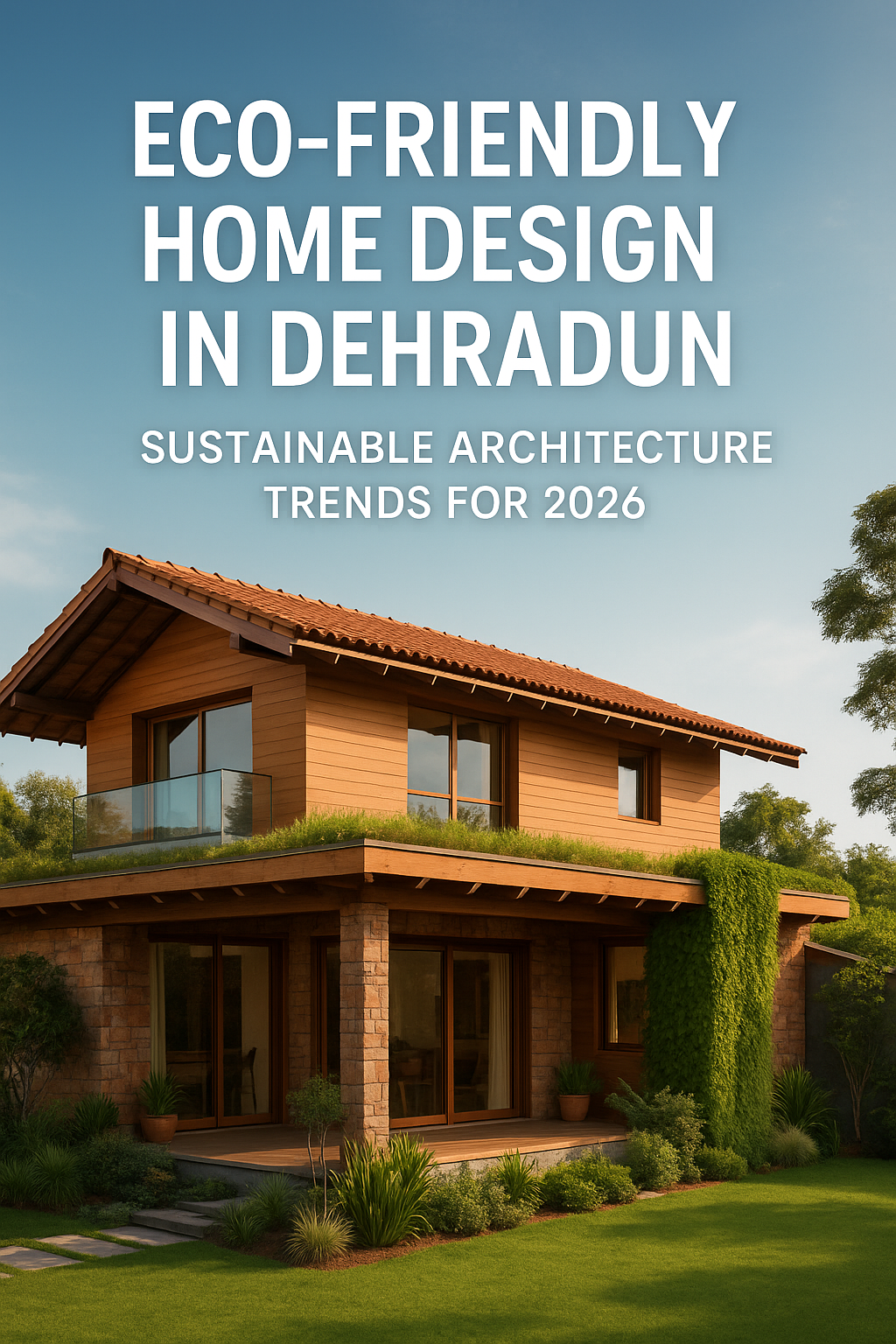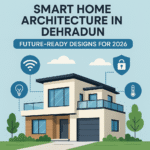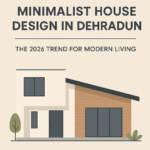Eco-Friendly Home Design in Dehradun: Sustainable Architecture Trends for 2026
Introduction: The Urgency of Sustainable Home Design in Dehradun
Dehradun, with its picturesque landscape and growing urban footprint, stands at a critical juncture. The rise in pollution, temperature shifts, and resource scarcity has accelerated the demand for eco-friendly and sustainable housing. As 2026 approaches, homebuyers, architects, and developers are turning their focus toward eco-conscious home design in Dehradun—combining smart technologies, green materials, and climate-resilient strategies.
This article explores the most relevant sustainable architecture trends for 2026, customised for Dehradun’s environment, lifestyle, and future growth.
1. Climate-Responsive Architecture for Dehradun’s Terrain
Passive Solar Design
Dehradun’s climate—with hot summers, cool winters, and seasonal rains—demands architecture that works with nature. Passive solar design, including north-south building orientation, insulated walls, thermal mass, and natural ventilation, reduces energy consumption while enhancing indoor comfort.
Shading and Cross Ventilation
Wider verandas, internal courtyards, jaali walls, and high clerestory windows allow for effective air movement and shade. This design is ideal for Dehradun’s valley location, where warm summer winds can be used for natural cooling if planned intelligently.
Sloped Roofs for Rainwater Harvesting
Steeply sloped roofs not only complement the region’s heritage look but also help manage heavy rainfall. Integrating gutters and tanks makes rainwater harvesting practical and visually harmonious.
2. Locally-Sourced & Low-Impact Materials
Kath-Kuni Inspired Techniques
Inspired by the traditional stone-and-wood construction of Uttarakhand, new eco-friendly home design in Dehradun is seeing a revival of Kath-Kuni architecture. This technique is known for its thermal performance and earthquake resistance, making it ideal for hillside homes.
Natural and Recycled Materials
Homeowners are increasingly choosing materials such as:
- Fly ash bricks (recycled industrial byproduct)
- Bamboo (fast-growing and renewable)
- Recycled wood and stone
- Lime plaster instead of cement
- Low-VOC (volatile organic compound) paints
These materials reduce carbon footprint while supporting local artisans and suppliers.
3. Green Roofs and Vertical Gardens
Rooftop Gardens
Green roofs act as insulation, lowering indoor temperatures and absorbing rainwater. In 2026, eco-conscious homes in Dehradun are incorporating rooftop gardens that double as edible landscapes with herbs, vegetables, and native flowers.
Vertical Greens
Walls with climbers or hydroponic systems are becoming common in compact plots. They offer aesthetics, improved air quality, and noise reduction—especially near busy roads like Rajpur Road or Sahastradhara Road.
4. Energy Efficiency and Smart Systems
Solar Power Integration
One of the key features of future-ready home design in Dehradun is solar energy. Solar rooftop panels or building-integrated photovoltaics (BIPV) are used to offset electricity consumption. Many homes now include battery storage and hybrid inverter systems to ensure reliability during outages.
Smart Home Automation
Homes in 2026 are equipped with:
- Smart lighting and HVAC systems
- Motion and light sensors
- App-controlled appliances
- Automated blinds and curtains
- Real-time energy tracking dashboards
These tools reduce electricity usage by up to 40% and support a comfortable, adaptive environment.
5. Water Conservation Techniques
Rainwater Harvesting Systems
Dehradun’s rainfall, if harvested properly, can sustain an average family’s water needs for several months. Homes are now being designed with sloped roofs, underground storage tanks, and natural filters for effective rainwater use.
Greywater Recycling
Greywater from showers, sinks, and washing machines is being reused for landscaping and flushing. This sustainable strategy reduces water consumption by 30–50%.
Drip Irrigation and Water-Smart Landscaping
Lawns are being replaced by native drought-resistant plants like lemongrass, jasmine, bougainvillaea, and seasonal vegetables. Automated drip systems ensure minimal water wastage.
6. Indoor Environmental Quality & Well-Being
Natural Ventilation and Daylighting
Well-placed windows, skylights, and light wells are essential for natural light. Besides reducing dependency on artificial lighting, these strategies improve mental health and connect residents with the outdoors.
Low-Toxicity Finishes
Future homes in Dehradun are being built with non-toxic paints, formaldehyde-free cabinets, and natural flooring (like cork, terracotta, or reclaimed wood) to ensure healthy indoor air quality.
Acoustic Comfort
Soundproofing with insulated walls and soft materials like jute curtains or felt panels creates peaceful interiors—especially crucial for homes near busy roads or within bustling colonies.
7. Modular and Prefabricated Construction
Quick, Efficient, and Sustainable
Prefabricated modular homes are trending in 2026 as efficient, less wasteful alternatives to conventional construction. Especially useful in hilly terrain, prefab panels reduce material transport, allow for precision construction, and minimise site disturbance.
Locally Adapted Kits
Modular homes designed specifically for home design in Dehradun feature:
- Sloped roofs for rain
- Insulated wall panels for year-round comfort
- Integrated solar systems
- Pre-fitted plumbing and energy-efficient lighting
8. Zero-Waste Construction Practices
Recycling Construction Debris
Waste materials such as stone chips, broken bricks, and steel scrap are being reused in boundary walls, garden beds, or sub-structures.
On-Site Composting
New homes now come with built-in composting bins for kitchen waste. The compost is reused for gardens, reducing the need for chemical fertilisers.
Use of Digital Design Tools
3D modelling and BIM (Building Information Modelling) software are helping architects plan efficient designs, reduce material overuse, and minimise errors.
9. Community-Driven and Shared Sustainability
Eco-Village Models
In areas like Sahastradhara and Mussoorie Road, gated communities are being developed with shared solar farms, community rainwater harvesting systems, and edible gardens.
Shared Electric Vehicle Charging
Homeowners are planning for EV future-readiness with shared electric vehicle charging stations in community parking lots—helping reduce carbon emissions further.
Walkability and Green Pathways
New housing layouts prioritise walking paths, native tree lines, and public greens. These designs promote healthier lifestyles while reducing car dependency.
10. Revival of Vernacular Design
Blending Modern with Traditional
Modern homes now borrow design inspiration from colonial bungalows, mud houses, and Himalayan wood-stone cabins—integrating them with glass, steel, and smart systems.
Sloping Roofs and Deep Verandas
These features not only reflect cultural heritage but also protect against rain and provide cool shaded spaces in summer.
Courtyard Homes
Traditional courtyard designs are returning—improving air circulation, offering safe play spaces for children, and serving as green breathing rooms within homes.
11. Certification and Green Ratings
GRIHA, IGBC, and LEED Standards
Homes in Dehradun aiming for sustainability are getting certified under national and international green building norms. These certifications help in:
- Reducing utility bills
- Increasing resale value
- Demonstrating environmental responsibility
Builder Transparency
Eco-conscious buyers are now asking builders to share material data, energy performance reports, and water efficiency plans before purchase—marking a new era of informed real estate.
12. The Economic Benefit of Going Green
Long-Term Cost Savings
Though green buildings cost 2–4% more upfront, they save significantly over time through:
- Lower electricity bills
- Reduced maintenance
- Government rebates and tax benefits
Increased Property Value
Buyers now value homes that are net-zero, smart, and health-friendly. Green features often fetch 10–15% higher resale prices.
13. What Homeowners Should Do in 2026
If you’re planning to build or buy a home in Dehradun in 2026:
- Work with architects specializing in sustainable design
- Use site-specific design: consider wind direction, sun path, and slope
- Prioritize local materials: stone, timber, lime, bamboo
- Invest in renewable energy: solar panels, solar geysers, and battery banks
- Plan water wisely: use tanks, greywater systems, native plants
- Embrace smart tech: reduce operational costs with automation
- Certify your home: aim for IGBC or GRIHA certification
Conclusion: A Greener, Smarter Future for Home Design in Dehradun
Eco-friendly architecture is no longer a luxury—it’s a necessity. With changing climate patterns, urban density, and resource stress, home design in Dehradun must evolve. The architecture of the future is one that:
- Heals the environment
- Respects cultural roots
- Promotes wellness and community
- Delivers economic value
Dehradun, with its unique mix of nature and urban growth, is perfectly poised to lead India’s green home revolution. Architects, builders, and homeowners working together can create beautiful, functional, and responsible homes that inspire a new standard for living in the Himalayas.






Leave a Reply